Le Bestie di Trieste
- Kathryn Casey

- Mar 25, 2024
- 8 min read
Okay, I'll admit it. That title is trying hard to be clever across two languages: In the Italian, "the beasts of Trieste" is a reference to some of the characters and statuary that made the city memorable for two human animals from America; to English speakers, I hope it will read as a play on The Best of Trieste.
It's a little tortured. But, then, so is the biography of the city...and, in fact, the lead-up to our visit there.
We didn’t know what to expect from our first-ever jaunt to Trieste, a port city way up on the Adriatic Coast comparatively few Americans seem to visit. In fact, we didn't know whether the trip would come off at all. A few weeks before our departure date, I’d dislocated, in a yoga class, the hip I’d had replaced nearly eight years ago. In case there’s any doubt, that’s not something you want to do twice. As the EMS guys hauled me out on a stretcher with towels and duct tape wrapped around me to stabilize my pelvis and with a fentanyl drip attached to my arm, the irony of the whole episode wasn't lost on me. I saw in my mind's eye what a pitiful advertisement I was for that unlucky yoga studio. (Twist 'n' Shriek Yoga: We {heart} stretchers!) That moment was no time for levity, so I made a mental note to laugh later. Anyway, I got the surgeon’s clearance to travel, though I had to be careful about how I moved, which many who know me also know is not my strong suit. And because I was forbidden to bend forward beyond a right angle or to raise my right knee beyond that same degree, Rosie had to put my socks and shoes on throughout the trip.
All that aside, there we were, checking into the Hotel Savoia Excelsior, right at the harbor and a matter of steps from the main piazza.

Rosie’s immediate impression was that Trieste was a city having an identity crisis. It looked like Venice. No, Imperial Rome. Possibly Austria. Maybe London. Her impression was pretty canny. Trieste’s timeline would make a good subject for a pop quiz designed to give the gotcha! to ill-prepared history students. In the centuries after the fall of the Roman Empire, it was Venetian, Austrian, Austro-Hungarian, Italian, German, Yugoslavian. Today, though part of Italy, it straddles Italian and Slovenian culture. Small wonder it might struggle with identity.
We stopped at Il Caffe' degli Specchi in Piazza Unita' d'Italia, one of the meccas of Trieste's "coffee culture," to get our bearings. Rosie's cappuccino was gorgeous and my American coffee with almond milk came with a side of drinking chocolate. I was struck by the breakfast menu. I'm used to seeing things like American breakfast vs Italian breakfast, but this one included not only Austrian and Balkan but Maldivian and Hawaiian breakfasts. Okay, so maybe Trieste sees itself as a kind of world crossroads.
I want to confess at the outset that this post is really flawed. We were there for two nights only and, thanks to my injury, we were a bit hamstrung in touring some of the places of interest in this partly hilly city. Moreover, our photos don't do the city justice. We somehow dropped the ball. Maybe we were preoccupied with keeping me upright. Whatever the case, please don't let Trieste suffer from being damned by faint photo praise. It is a highly walkable city with unexpected urban configurations around every corner. It's full of surprises big and small. The architecture is varied, the churches many and distinctive, the statuary intriguing.
There's the Grand Canal in the middle of the city...

...surrounded by several important places of worship I want to mention so you won't miss them the way we did. The canal is anchored by the Church of Sant'Antonio, the city's largest Catholic church.
To the right is the commanding Church of Saint Spyridon, one of only three Serbian Orthodox churches in Italy. Nearby is the Great Synagogue of Trieste, evidently one of the largest synagogues in Europe.
Visits to the synagogue are by-appointment-only and both churches close for lunch, which was the only time we could get there.
There's statuary almost everywhere you look, including this guy who looks like an over-dressed and over-qualified crossing guard; what appear to be two contemporary finance guys in fig leaves (casual Friday?); and what I'm guessing are slaves outside the Deutsche bank. No comment.
We headed up to see the fortified San Giusto Castle, excited to walk the wooden bridge over its moat, but had to turn back because the ascent became pretty steep and slippery in the rain and I'd been warned off anything that looked like hiking or climbing. On our way down, we happened upon a little gem of a church that turned out to be the oldest one in the city, the 11th/12th century Basilica di San Silvestro. Inside are the remains of a fresco that recounts a legend about Constantine being advised to order the slaughter of children so he might bathe in their blood as a cure for his leprosy. In the legend, he decided against it and sought the advice of a pope, who bathed him in holy water instead. The apocryphal episode in the life of Constantine created a long tail of bickering in the Church before being debunked by a 15th Century scholar. However, the frescoes in this church predate that scholarship. What's left of them you can see below. The photo immediately below at right shows part of a display inside the church that gives a better idea of what they once looked like.
Around the corner, the church of Santa Maria Maggiore has a lot of strikingly graphic/geometric stained glass that appealed to me. Thank you, Rosie, for demonstrating proper parochial school pew posture for us.
Here's something I'd never seen before: uncommonly helpful signs that actually give step counts to nearby attractions. Now the hobbled tourist would know just what she was getting into in the rain. I put the counts to the test, and they proved pretty accurate. Nice touch, Trieste.

As the sign says, 245 steps away is a remarkably intact Roman amphitheater. Need to grab some tomatoes at the neighborhood Despar supermarket? Just take a left at the theater. There shouldn’t be a crowd since the last performance was 2,000 years ago. The jarring juxtaposition of the ordinary and extraordinary reminded me of the first glimpse I had of the Great Sphinx when I visited Cairo. We were just driving on some highway or other when off to the right something caught our eyes. “Hey, watch that guy who's about to cut you off. And look, there’s the Sphinx.”
A few blocks away, near the heart of the shopping district, is the original Borsa, or Stock Exchange, today the Chamber of Commerce. Neptune predates it, but now is forced to gaze at it into perpetuity.
Several steps to the left, Gabriele D’Annunzio, the literary darling and political madman of late 19th/early 20th century Italy, sits on a bench and reads. I long assumed D'Annunzio to be an over-exposed, tiresome pain in the glutes. He was born in Pescara (Abruzzo), so I've had a pretty steady diet of “D’Annunziano this” and “D’Annunziano that” during my time in the region. I knew he was inclined toward fascism and sexual excess but was nonetheless a gifted novelist and poet. However, I'd never read much about him until I saw him memorialized here. Turns out he was a dangerous and repellent man and in many ways a precursor to an equally repellent man of our own times, albeit a far braver, better educated, and more eloquent one. In 1919, D'Annunzio declared himself dictator of Fiume (now Rijeka, Croatia) and reigned as such for a year until the Italian government had had enough of his antics and slapped him down. Many Italians still revere him, be it for his fascist proclivities, outsized appetite for debauchery, or literary gifts. So is he reading poetry? porn? politics? He ain't saying.

We puzzled over the meaning of this unmissable banner in the heart of the shopping area:

Were the commercial enterprises imploring their best tourists and customers to come back after Covid? Had American and English tourists abandoned Trieste for some other reason? We'd later ask a native who’d become our guide, and the answer proved even more intriguing. He told us the call to "come back" referred to the good old days following World War II when the city became the capital of the Free Territory of Trieste under the protection of the Allied Military (US and UK)--before the territory was ultimately divided between Yugoslavia and Italy.
Those, apparently, are the times Triestians still consider the glory days.
Trieste is a city of two languages (as you'll see on the road sign below) and two cuisines. You can get familiar Italian food, but many restaurants are a mash-up of Italian and Slovenian cooking. The Slovenian dishes were meat-dominated, so I stuck to vegetable sides. I did taste the traditional soup Rosie ordered, which was basically a pasta e fagioli -- no doubt with sausage lurking somewhere -- with the addition of some species of sauerkraut. The combo did little for either of us.

We had two dinners that were perfectly acceptable but nothing special. If you go to Trieste, you might want to try a place called Suban, which we didn't manage to get into. It's known for its traditional Triestine fare and for the fact that Pope John Paul chose to eat there when he visited the city.
When we couldn’t take the Trieste tram-cum-funicular up into the hills because it had ceased running (doh!), we happened upon taxi driver Ricardo, who became a memorable feature of our visit to Trieste – and one I recommend including in your visit as a guide and driver. He's lovely and his price was more than fair. If you're interested, please message me and I'll send you his contact info.

As we climbed and Ricardo narrated, we had a nice view of the bay. Please note the craft that appears just about at the beginning of the right one-third of the photo below. We’d spotted it from the train window on our approach into the city and commented on its striking silhouette. Turns out it was designed by Philippe Starck, belongs to a Russian oligarch, and is worth billions. It’s been sequestered there in the bay since 2020. The Italian government, together with other European governments, has been seizing the property of oligarchs so they can’t use assets to fund the war on Ukraine. Bravo, Europe!
We crossed through Prosecco, the town that gave birth to...what was it again? Let me have a sip and think. And here I thought Prosecco was the province of the Veneto.

What we really wanted to see was the Santuario di Monte Grisa atop the hill. We'd spotted it from the center of the city and wondered what that strange-looking building was. The Santuario is a Marian temple built in the 1960s and shaped like an M in Mary’s honor. (It's rather irreverently called the formaggino, or cheese triangle, by locals.)
I've never seen a church like it for scale or style. Rosie, a fan of Brutalist architecture, was spellbound.
It's got a number of altars and leviathan frescoes of Mary inside. If you go, wear sensible shoes. I almost got blown right off the bluffs trying to enter from the wuthering Adriatic side.
We didn't realize before we got to Trieste that the Nazis had left their mark there. One example is the gorgeous seaside Miramare Castle, which they seized and established as a temporary headquarters. On the approach to the castle, you can still see the remains of three cannon stations.

Trieste is also the site of the only concentration camp in what is now Italy. That's not something that gets a lot of airtime. Ricardo mentioned it, so we ran over there in the morning before catching the train to Venice. It was, of course, a bleak note on which to say goodbye -- for now -- to a many-faceted city.
Coming soon: A new perspective on Venice







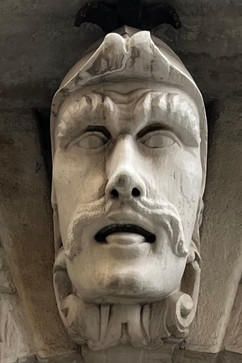























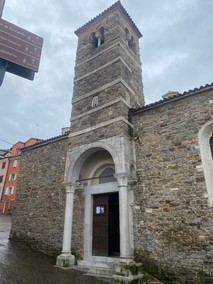






























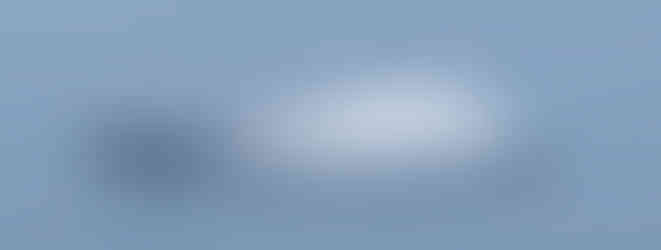






















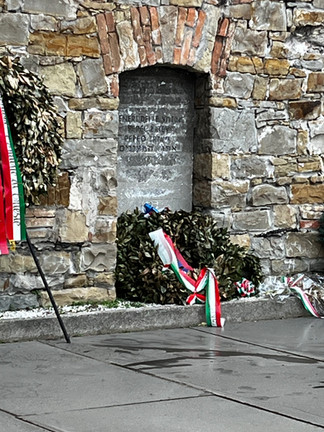
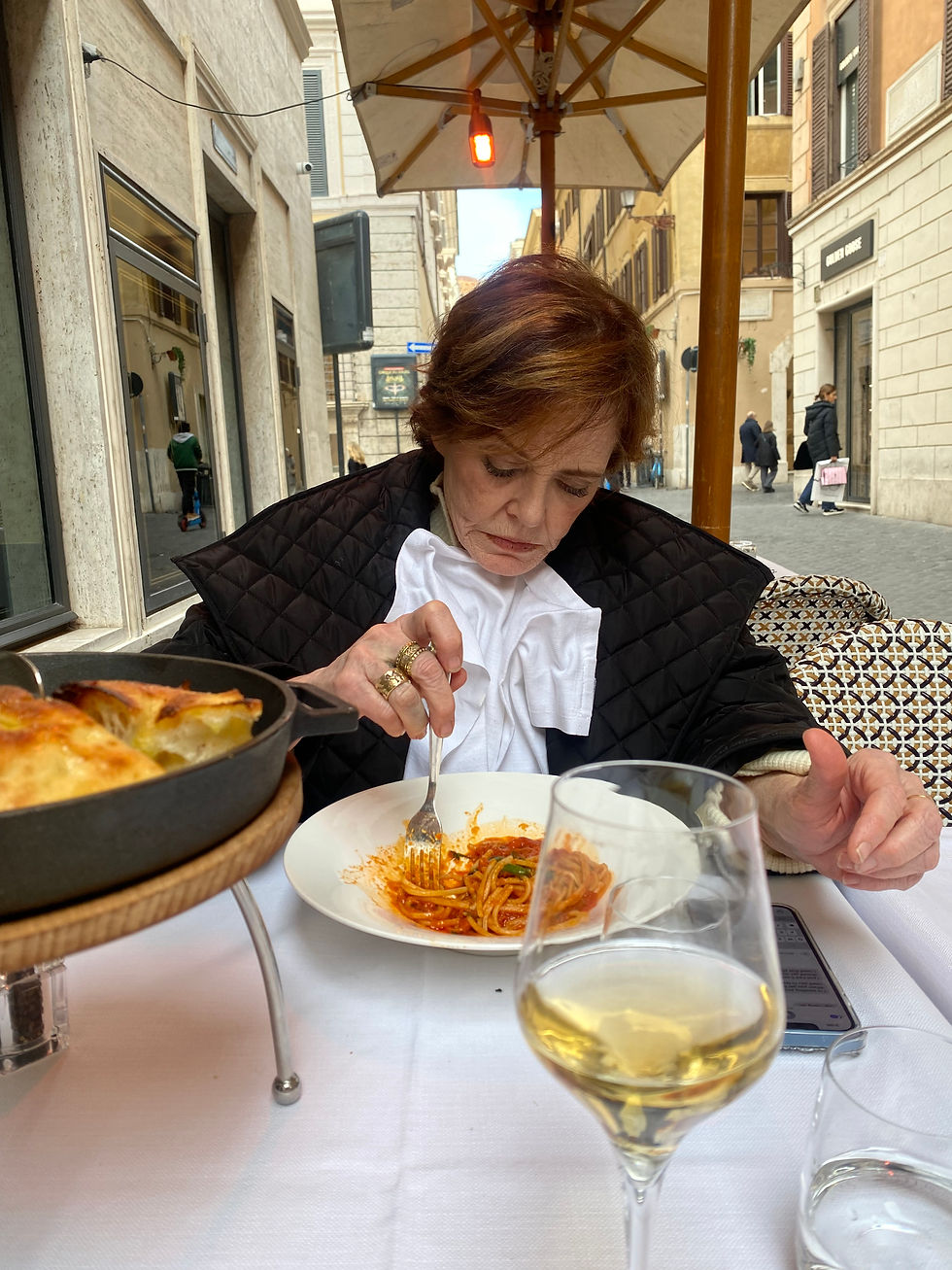




Comments